- October is historically the most volatile month for markets, though broader Q4 often most profitable
- Q3 earnings from an array of US companies may pull the spotlight back to inflation
Metrics released on Friday showed a faster pace of growth than expected in September for US Manufacturing and ISM Manufacturing PMIs. Stocks received an additional boost from news of the phase-3 trial success of Merck's (NYSE:MRK) molnupiravir COVID drug. However, it's likely that investor focus will return to worries about inflation, along with Federal Reserve tightening as the spotlight shines on company results in the week ahead with earnings season on the horizon.
Adding to potential market jitters—this coming Friday’s monthly Nonfarm Payrolls print, a key release for the US economy, along with the delayed, but not yet concluded, legislative tussle over the US debt ceiling. As well, markets are still contending with ongoing worries about China's Evergrande Group (OTC:EGRNY) (HK:3333), as the giant real estate developer continues to struggle with its massive debt overload. In short, there are a plethora of themes that could pressure markets as the first full week of October trading commences.
Mixed Forecasts, Market Jitters, Possible SPX Reversal
Mad Money’s Jim Cramer expects profit-taking will weigh on shares as quarterly earnings—which could reflect some of the worst days of the pandemic—are released. Other analysts point to the October Effect, an accepted perception that equity markets generally decline during the month, on added volatility, even as the fourth quarter, which starts in October, often provides positive returns overall.
Yet other strategists are forecasting rising equities, perhaps even fresh records, despite the Fed beginning to withdraw stimulus and the pandemic continuing to constrain global supply chains, an additional inflation trigger.
According to CFRA Research, since WWII, the S&P 500 Index, gained 3.9% on average during the fourth quarter and was positive 80% of the time. That would make Q4 the best quarter of the year during the period studied.
However, even if the broad benchmark matched or exceeded those statistics, to reap those gains in 2021 investors would still have to weather the historically tumultuous month of October, which saw 36% higher volatility when compared to other months of the year.
There are already signs of the expected oscillation currently visible via the tug-of-war between supply and demand on the S&P 500, whose medium-term trajectory may have reversed.

The SPX completed a small H&S top, as the benchmark fell below the 100 DMA for the first time in almost a year, since late October 2020. The price remains below the 50 DMA, which has been a natural uptrend line for much of the time since crossing above it in April 2020.
The RSI fell below its support line since February 2020. The recent equity rise may well be nothing more than part of a return move, providing traders with an opportunity for a short at an optimum entry.
Though Utilities were flat, the 10 remaining S&P 500 sectors finished in the green on Friday, pushing the index up 1.15%. However, the broad benchmark was down for the week along with all sectors except Energy, which was up 5.8% for the period. Health Care (-3.5%) and Technology (-3.3%) underperformed.
On a monthly basis the S&P suffered in September; the gauge saw its first monthly decline in nine months. It dropped 4.8%, its worst performance since the infamous March 2020 bottom, preceding the uptrend marked by the 50 DMA.
Here are some SPX components worth watching in the week ahead:
Meme stock AMC Entertainment Holdings (NYSE:AMC): The much anticipated sequel to Marvel Comic's Venom series has its cinematic release this weekend. Ticket sales are expected to be robust, perhaps the strongest since the pandemic started.
One catalyst driving up potential sales could be CEO Adam Aron's tweet on Thursday that shareholders, who are also AMC Investor Connect members, can purchase a ticket and bring a friend for free all weekend long.
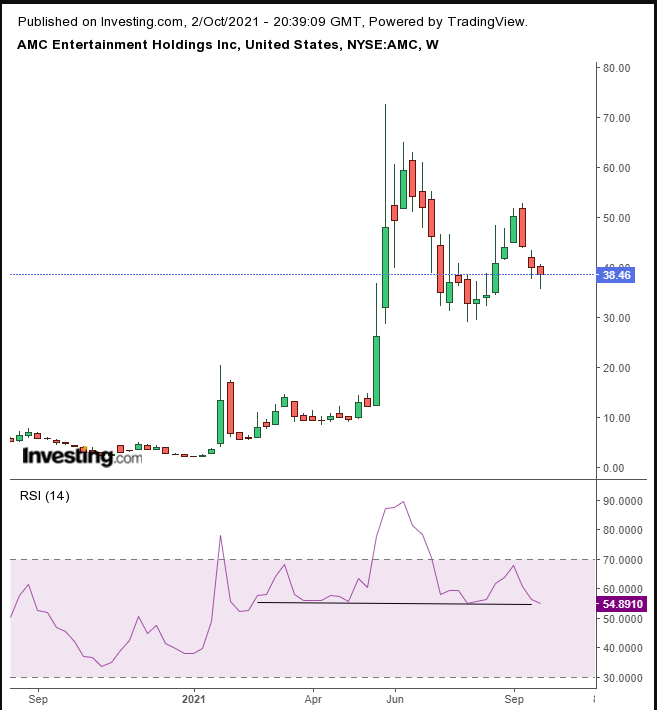
The stock has been moving sideways, while the weekly RSI formed a H&S top.
Soft drink and snack giant PepsiCo (NASDAQ:PEP) releases Q3 earnings on Tuesday, Oct. 5, before the market open. Consensus estimates call for EPS of $1.73 on revenue of $19.32 billion. However, supply chain problems may have cut into the beverage maker’s profits.
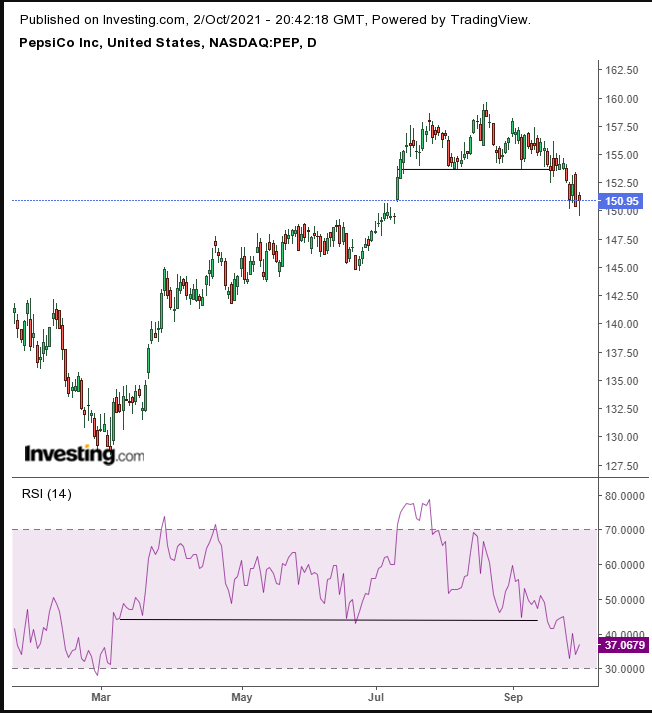
From a technical perspective, the stock completed a H&S top, similar to that of S&P 500. Its RSI broke a support that's been in place since March.
Both beer, wine, and spirits maker Constellation Brands (NYSE:STZ) and apparel manufacturer Levi Strauss (NYSE:LEVI) report earnings on Tuesday, the former ahead of the open, the latter after the close.
Consensus expectations for STZ are for EPS of $2.78 on $2.3 billion in revenue, up from a $2.76 EPS and $2.26 billion revenue for the same quarter last year.
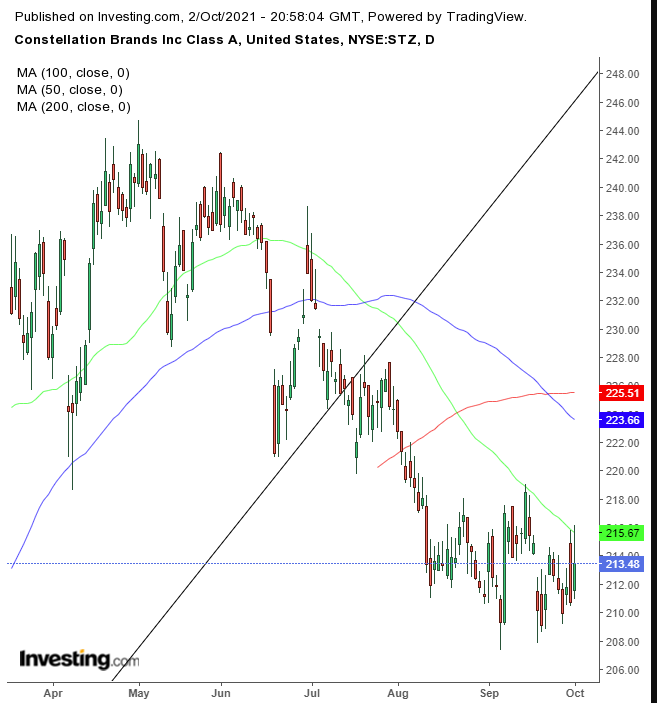
Technically, there's an argument to be made that Constellation Brands may have bottomed ahead of earnings. However, traders should note that the stock fell below its uptrend line, with moving averages in a bearish formation, as each shorter MA crossed below its longer counterparts.
The consensus expectation for iconic jeans-maker Levi Strauss is for an EPS of $0.3736, on $1.48 billion in revenue, significantly higher than last year’s $0.08 EPS and $1.06 billion revenue.
Growing demand for denim—perhaps because people have been spending less time in office attire as many continue to work from home—is expected to boost sales for Levi Strauss.
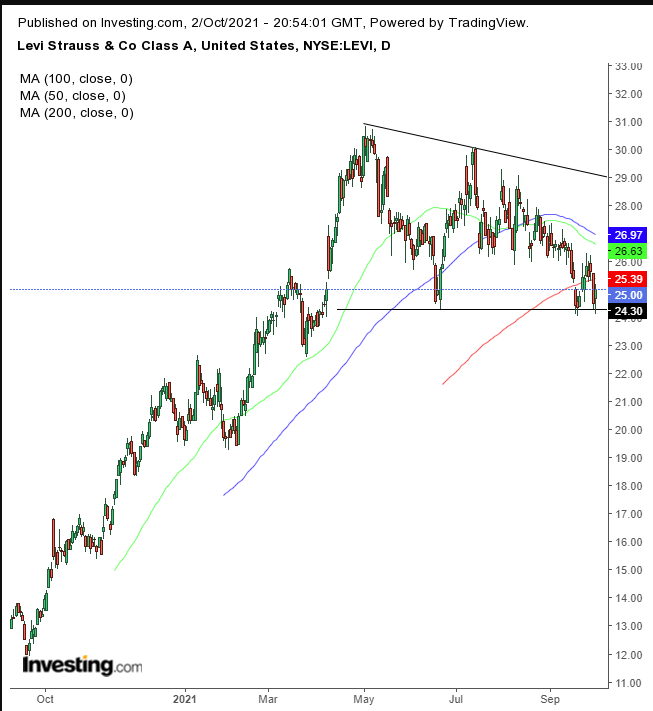
From a technical standpoint, the price fell below the 200 DMA, as it tests the bottom of a descending triangle. A close below $24.00 would set the stage for a downward spiral.
Packaged foods behemoth Conagra (NYSE:CAG) just increased its quarterly dividend payment beginning Dec. 1, 2021, for shareholders in possession of the stock on Nov. 1. This may have saved the Chicago-based giant's shares from a rout ahead of its earnings release on Thursday, Oct. 7, before the open.
Consensus expectations are calling for EPS of $0.48 on revenue of $2.52 billion. The company is likely to have been affected by ongoing global distribution problems which include a scarcity of critical soft commodities.
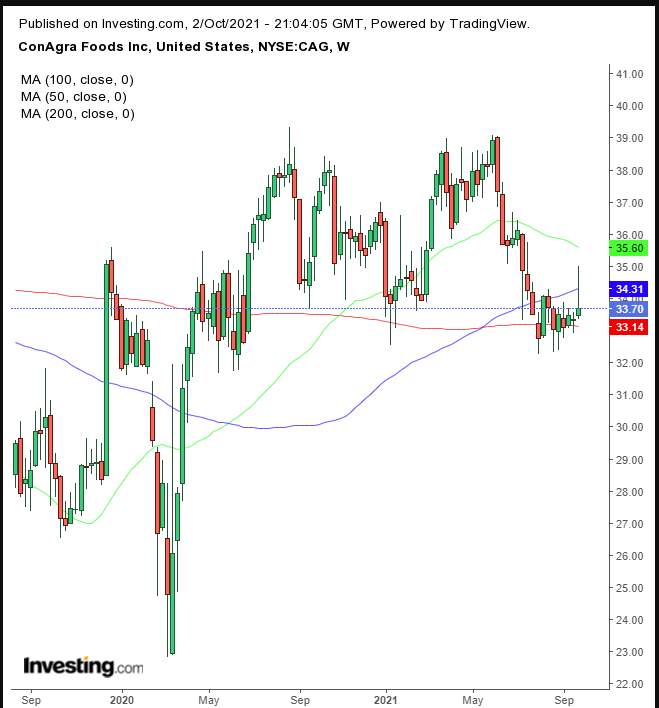
The stock fell below both the 50 and 100 WMAs. Shares are now testing the 200-week MA, the natural neckline of a massive double-top since June 2020.
Perhaps the market's most anticipated event this coming week occurs on Friday. That would be a potentially explosive NFP release, which could go in either direction.
After the recent hawkish shift in tone from the US central bank, Fed Chair Jerome Powell needs extremely weak numbers in order to keep dragging his feet on tapering. If the release comes in too high the Fed may be forced to tighten more quickly, whereas substantially weaker than expected figures could send markets into a taper tantrum.
The Week Ahead
All times listed are EDT
China's markets will be closed till Friday for a national holiday.
Monday
20:30: Australia – Retail Sales: previous print showed a drop of -1.7%.
23:30: Australia – RBA Interest Rate Decision: forecast to hold at 0.10%.
Tuesday
4:30: UK – Services PMI: seen to remain flat 54.1.
10:00: US – ISM Non-Manufacturing PMI: expected to decline to 60.0 from 61.7.
21:00: New Zealand – RBNZ Interest Rate Decision: anticipated to hike to 0.50% from 0.25%.
Wednesday
4:30: UK – Construction PMI: likely to have edged down to 55.0 from 55.2.
8:15: US – ADP Nonfarm Employment Change: probably declined to 430K from 374K.
10:30: US – Crude Oil Inventories: printed at 4.578M bbl last week.
Thursday
7:30: Eurozone – ECB Publishes Account of Monetary Policy Meeting
8:30: US – Initial Jobless Claims: predicted to narrow to 350K from 362K.
10:00: Canada – Ivey PMI: August reading came in at 63.8.
Friday
8:30: US – Unemployment Rate: anticipated to have edged down to 5.1% from 5.21%.
8:30: Canada – Employment Change: seen to have plunged to 60.0K from 90.2K.
